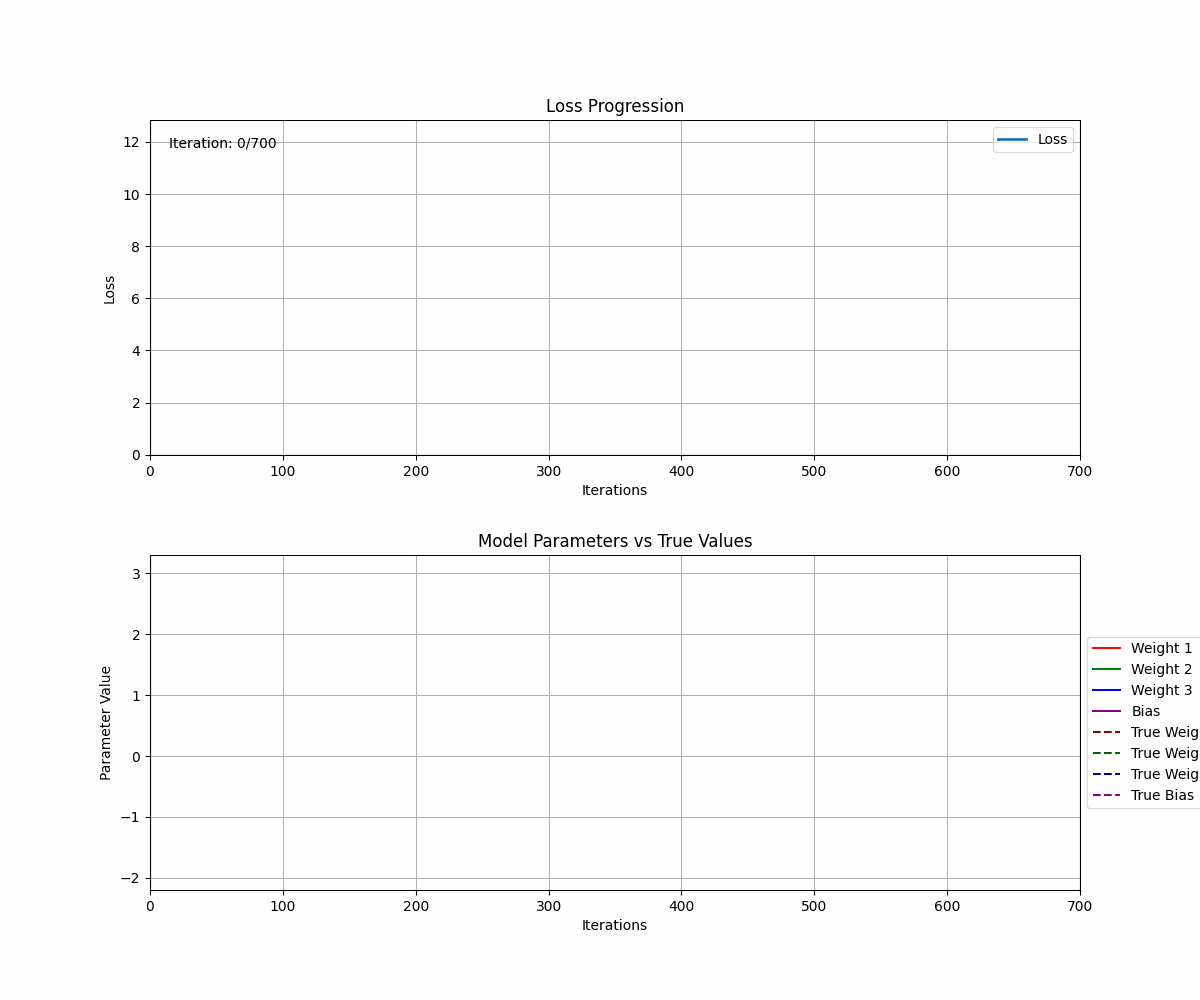
Multiple Linear Regression (MLR) is a statistical method that models the relationship between a dependent variable and multiple independent variables. It extends simple linear regression, which uses a single feature to predict the outcome, to handle multiple features. The general form of the MLR equation is:
Where:
The goal of multiple linear regression is to estimate the coefficients
We'll implement multiple linear regression from scratch using two different methods:

To demonstrate the MLR model, we first generate synthetic data. For this example, we will create a dataset with three features, where the true relationship is:
The noise is added to simulate real-world data variability, making it more challenging for the model to fit the data perfectly.
We implement the model using two methods: Gradient Descent and Normal Equation.
Gradient descent is an optimization algorithm used to minimize the loss function. In the case of linear regression, the loss function is the Mean Squared Error (MSE). Gradient descent iteratively adjusts the model's parameters to find the values that minimize the loss.
import numpy as np class MultipleLinearRegression: def __init__(self, learning_rate=0.01, n_iterations=1000): self.learning_rate = learning_rate self.n_iterations = n_iterations self.weights = None self.bias = None self.history = {'loss': [], 'weights': [], 'bias': []} def predict(self, X): return np.dot(X, self.weights) + self.bias def fit(self, X, y): n_samples, n_features = X.shape self.weights = np.zeros(n_features) self.bias = 0 for i in range(self.n_iterations): y_predicted = self.predict(X) # Compute gradients dw = (1/n_samples) * np.dot(X.T, (y_predicted - y)) db = (1/n_samples) * np.sum(y_predicted - y) # Update parameters self.weights -= self.learning_rate * dw self.bias -= self.learning_rate * db # Track loss and parameters loss = np.mean((y_predicted - y) ** 2) self.history['loss'].append(loss) self.history['weights'].append(self.weights.copy()) self.history['bias'].append(self.bias)
The normal equation provides a closed-form solution to calculate the optimal weights directly. It avoids the need for iterative optimization but can be computationally expensive for large datasets.
Where:
class MultipleLinearRegressionNormal: def __init__(self): self.weights = None self.bias = None def predict(self, X): return np.dot(X, self.weights) + self.bias def fit(self, X, y): # Add bias term (column of ones) to the feature matrix X_b = np.c_[np.ones((X.shape[0], 1)), X] # Compute the optimal weights using the normal equation betas = np.linalg.inv(X_b.T @ X_b) @ X_b.T @ y # Separate bias and weights self.bias = betas[0] self.weights = betas[1:]
After defining the models, we proceed to train them using the generated synthetic data. The dataset is split into training and testing sets, and the models are fitted to the training data.
# Generate synthetic data X, y = generate_data() X_train, X_test, y_train, y_test = train_test_split(X, y, test_size=0.2, random_state=42) # Scale the features (important for gradient descent) scaler = StandardScaler() X_train_scaled = scaler.fit_transform(X_train) X_test_scaled = scaler.transform(X_test) # Train Gradient Descent Model gd_model = MultipleLinearRegression(learning_rate=0.06, n_iterations=700) gd_model.fit(X_train_scaled, y_train) # Train Normal Equation Model normal_model = MultipleLinearRegressionNormal() normal_model.fit(X_train_scaled, y_train)
After training, we evaluate both models using the R² score, which measures the proportion of variance explained by the model. A higher R² score indicates a better model fit.
The R² (R-squared), or coefficient of determination, is a statistical measure that indicates how well the independent variables explain the variance in the dependent variable. The formula for R² is:
Where:
from sklearn.metrics import r2_score # Evaluate the models gd_predictions = gd_model.predict(X_test_scaled) normal_predictions = normal_model.predict(X_test_scaled) print("Gradient Descent Model R² Score:", r2_score(y_test, gd_predictions)) print("Normal Equation Model R² Score:", r2_score(y_test, normal_predictions))

Visualizing the training process can help us understand the model’s convergence. We plot the loss progression over iterations and track how the weights change during training.
import matplotlib.pyplot as plt # Plot loss progression plt.figure(figsize=(10, 5)) plt.subplot(1, 2, 1) plt.plot(gd_model.history['loss']) plt.title('Loss Progression') plt.xlabel('Iterations') plt.ylabel('Mean Squared Error') # Plot weight changes plt.subplot(1, 2, 2) weights_history = np.array(gd_model.history['weights']) for i in range(weights_history.shape[1]): plt.plot(weights_history[:, i], label=f'Weight {i+1}') plt.title('Weight Progression') plt.xlabel('Iterations') plt.ylabel('Weight Value') plt.legend() plt.tight_layout() plt.show()
Here’s the complete code combining all steps:
import numpy as np import matplotlib.pyplot as plt from sklearn.model_selection import train_test_split from sklearn.metrics import r2_score from sklearn.preprocessing import StandardScaler # Set random seed for reproducibility np.random.seed(42) # Generate synthetic data def generate_data(n_samples=100, n_features=3): X = np.random.randn(n_samples, n_features) true_coefficients = np.array([3, 1.5, -2]) noise = np.random.normal(0, 0.5, n_samples) y = 2 + np.dot(X, true_coefficients) + noise return X, y # Generate and prepare data X, y = generate_data() X_train, X_test, y_train, y_test = train_test_split(X, y, test_size=0.2, random_state=42) # Scale the features scaler = StandardScaler() X_train_scaled = scaler.fit_transform(X_train) X_test_scaled = scaler.transform(X_test) # Train Gradient Descent Model gd_model = MultipleLinearRegression(learning_rate=0.06, n_iterations=700) gd_model.fit(X_train_scaled, y_train) # Train Normal Equation Model normal_model = MultipleLinearRegressionNormal() normal_model.fit(X_train_scaled, y_train) # Evaluate models gd_predictions = gd_model.predict(X_test_scaled) normal_predictions = normal_model.predict(X_test_scaled) print("Gradient Descent Model R² Score:", r2_score(y_test, gd_predictions)) print("Normal Equation Model R² Score:", r2_score(y_test, normal_predictions)) # Visualization plt.figure(figsize=(12, 5)) plt.subplot(1, 2, 1) plt.plot(gd_model.history['loss']) plt.title('Loss Progression') plt.xlabel('Iterations') plt.ylabel('Mean Squared Error') plt.subplot(1, 2, 2) weights_history = np.array(gd_model.history['weights']) for i in range(weights_history.shape[1]): plt.plot(weights_history[:, i], label=f'Weight {i+1}') plt.title('Weight Progression') plt.xlabel('Iterations') plt.ylabel('Weight Value') plt.legend() plt.tight_layout() plt.show()
By implementing multiple linear regression from scratch, we gain a deeper understanding of the underlying mechanics of regression models. The two methods—Gradient Descent and Normal Equation—offer different trade-offs in terms of complexity and computational efficiency. Gradient Descent is more flexible and scales well with large datasets, while the Normal Equation provides a direct solution, making it faster for smaller datasets.
Gradient Descent to converge efficiently.
If you're looking to dive deeper into linear regression and machine learning, here are some great resources:
Feel free to reach out with any questions or thoughts. Happy learning and coding!